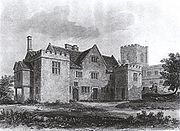
Edington Priory
Encyclopedia

Wiltshire
Wiltshire is a ceremonial county in South West England. It is landlocked and borders the counties of Dorset, Somerset, Hampshire, Gloucestershire, Oxfordshire and Berkshire. It contains the unitary authority of Swindon and covers...
, England
England
England is a country that is part of the United Kingdom. It shares land borders with Scotland to the north and Wales to the west; the Irish Sea is to the north west, the Celtic Sea to the south west, with the North Sea to the east and the English Channel to the south separating it from continental...
, was founded by William Edington, the bishop of Winchester
Bishop of Winchester
The Bishop of Winchester is the head of the Church of England diocese of Winchester, with his cathedra at Winchester Cathedral in Hampshire.The bishop is one of five Church of England bishops to be among the Lords Spiritual regardless of their length of service. His diocese is one of the oldest and...
, in 1332 in his home village of Edington
Edington, Wiltshire
Edington is a small village and civil parish in Wiltshire, England, about five miles east of Westbury.The parish includes two principal settlements, Edington village and Tinhead, which lies between the main village and Coulston and contains the parish's only surviving public house, The Paulet Arms...
. The priory church was built between 1352 and 1361.
History
What was originally a college for priests later became a monastery for Augustinian canons. The Catholic EncyclopediaCatholic Encyclopedia
The Catholic Encyclopedia, also referred to as the Old Catholic Encyclopedia and the Original Catholic Encyclopedia, is an English-language encyclopedia published in the United States. The first volume appeared in March 1907 and the last three volumes appeared in 1912, followed by a master index...
claims that it was granted by Edward the Black Prince to the Brothers of Penitence
Brothers of Penitence
The Brothers of Penitence or Fratres Saccati were an Augustinian order also known as Boni Homines, Bonshommes or Bones-homes. They were also known as the "Bluefriars" on account of the colour of their robes.-History:...
.
The first rector, brought from Ashridge Priory
Ashridge Priory
Ashridge Priory was a medieval abbey of the Brothers of Penitence.The seventeenth century historian Polydore Vergil said that Edmund founded in 1283 a monastery at Ashridge, Hertfordshire, for a rector and twenty canons of "a new order not before seen in England, and called the Boni homines"...
, was John de Aylesbury, the last John Ryve. Edward VI
Edward VI of England
Edward VI was the King of England and Ireland from 28 January 1547 until his death. He was crowned on 20 February at the age of nine. The son of Henry VIII and Jane Seymour, Edward was the third monarch of the Tudor dynasty and England's first monarch who was raised as a Protestant...
granted the property to William Paulet, Baron St John
William Paulet, 1st Marquess of Winchester
Sir William Paulet was an English Secretary of State and statesman who attained several peerages throughout his lifetime: Baron St John , Earl of Wiltshire , and Marquess of Winchester .-Family origins and early career in Hampshire:William Paulet was eldest son of Sir John Paulet of...
; by the 19th century it belonged to the Watson-Taylor family.
During Jack Cade
Jack Cade
Jack Cade was the leader of a popular revolt in the 1450 Kent rebellion during the reign of King Henry VI in England. He died on the 12th July 1450 near Lewes. In response to grievances, Cade led an army of as many as 5,000 against London, causing the King to flee to Warwickshire. After taking and...
's rebellion in 1450, William Ayscough
William Ayscough
William Ayscough was a medieval Bishop of Salisbury.He was nominated on 11 February 1438 and consecrated on 20 July 1438....
, Bishop of Salisbury
Bishop of Salisbury
The Bishop of Salisbury is the ordinary of the Church of England's Diocese of Salisbury in the Province of Canterbury.The diocese covers much of the counties of Wiltshire and Dorset...
and confessor to Henry VI
Henry VI of England
Henry VI was King of England from 1422 to 1461 and again from 1470 to 1471, and disputed King of France from 1422 to 1453. Until 1437, his realm was governed by regents. Contemporaneous accounts described him as peaceful and pious, not suited for the violent dynastic civil wars, known as the Wars...
, was forced to flee Salisbury
Salisbury
Salisbury is a cathedral city in Wiltshire, England and the only city in the county. It is the second largest settlement in the county...
. Seeking refuge in the church at Edington, he was discovered on June 29, dragged from the high altar during mass and murdered in the fields outside the church.
The church still stands today, a good example of the transition between the decorated and perpendicular style of church-building. It contains the burial monuments of several local notables, including tombs removed from St Giles at Imber
Imber
Imber is an uninhabited village in part of the British Army's training grounds on the Salisbury Plain, Wiltshire, England. It is situated in an isolated area of the Plain, about west of the A360 road between Tilshead and West Lavington, accessible only by military tracks...
during the early 1950s - following the evacuation of the village in 1943.
Every August a festival of church music is held there.

